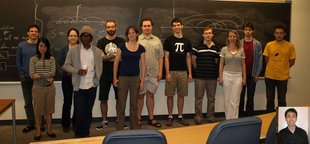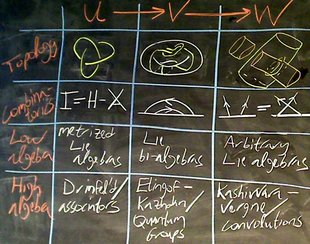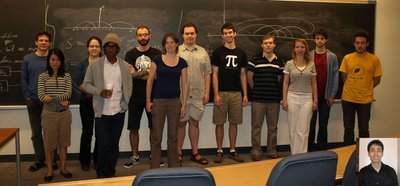AKT-09/HW1: Difference between revisions
No edit summary |
No edit summary |
||
| (4 intermediate revisions by 2 users not shown) | |||
| Line 1: | Line 1: | ||
{{AKT-09/Navigation}} |
{{AKT-09/Navigation}} |
||
{{In Preparation}} |
|||
'''Solve the following problems''' and submit them in class by October 13, |
'''Solve the following problems''' and submit them in class by October 13, 2009: |
||
'''Problem 1.''' If <math>f \in {\mathcal V}_n</math> and <math>g \in {\mathcal V}_m</math> then <math>f \cdot g \in {\mathcal V}_{n+m}</math> (as what one would expect by looking at degrees of polynomials) and <math>W_{f \cdot g} = m_\mathbb{Q} \circ (W_f \otimes W_g) \circ \ |
'''Problem 1.''' If <math>f \in {\mathcal V}_n</math> and <math>g \in {\mathcal V}_m</math> then <math>f \cdot g \in {\mathcal V}_{n+m}</math> (as what one would expect by looking at degrees of polynomials) and <math>W_{f \cdot g} = m_\mathbb{Q} \circ (W_f \otimes W_g) \circ \Box</math> where <math>(W_f \otimes W_g) \circ \Box: {\mathcal A} \rightarrow \mathbb{Q} \otimes \mathbb{Q}</math> and <math>m_\mathbb{Q}</math> is the multiplication of rationals. (See {{AKT-09/vps|0924-2}}, minute 36:01). |
||
'''Problem 2.''' Let <math>\Theta:{\mathcal A}\to{\mathcal A}</math> be the multiplication operator by the 1-chord diagram <math>\theta</math>, and let <math>\partial_\theta=\frac{d}{d\theta}</math> be the adjoint of multiplication by <math>W_\theta</math> on <math>{\mathcal A}^\star</math>, where <math>W_\theta</math> is the obvious dual of <math>\theta</math> in <math>{\mathcal A}^\star</math>. Let <math>P:{\mathcal A}\to{\mathcal A}</math> be defined by |
'''Problem 2.''' Let <math>\Theta:{\mathcal A}\to{\mathcal A}</math> be the multiplication operator by the 1-chord diagram <math>\theta</math>, and let <math>\partial_\theta=\frac{d}{d\theta}</math> be the adjoint of multiplication by <math>W_\theta</math> on <math>{\mathcal A}^\star</math>, where <math>W_\theta</math> is the obvious dual of <math>\theta</math> in <math>{\mathcal A}^\star</math>. Let <math>P:{\mathcal A}\to{\mathcal A}</math> be defined by |
||
| Line 10: | Line 9: | ||
{{Equation*|<math>P = \sum_{n=0}^\infty \frac{(-\Theta)^n}{n!}\partial_\theta^n.</math>}} |
{{Equation*|<math>P = \sum_{n=0}^\infty \frac{(-\Theta)^n}{n!}\partial_\theta^n.</math>}} |
||
Verify the following assertions, but submit only your work on assertions 4,5,7,11: |
|||
# <math>\left[\partial_\theta,\Theta\right]=1</math>, where <math>1:{\mathcal A}\to{\mathcal A}</math> is the identity map and where <math>[A,B]:=AB-BA</math> for any two operators. |
# <math>\left[\partial_\theta,\Theta\right]=1</math>, where <math>1:{\mathcal A}\to{\mathcal A}</math> is the identity map and where <math>[A,B]:=AB-BA</math> for any two operators. |
||
| Line 16: | Line 15: | ||
# <math>\partial_\theta</math> satisfies Leibnitz' law: <math>\partial_\theta(ab)=(\partial_\theta a)b+a(\partial_\theta b)</math> for any <math>a,b\in{\mathcal A}</math>. |
# <math>\partial_\theta</math> satisfies Leibnitz' law: <math>\partial_\theta(ab)=(\partial_\theta a)b+a(\partial_\theta b)</math> for any <math>a,b\in{\mathcal A}</math>. |
||
# <math>P</math> is an algebra morphism: <math>P1=1</math> and <math>P(ab)=(Pa)(Pb)</math>. |
# <math>P</math> is an algebra morphism: <math>P1=1</math> and <math>P(ab)=(Pa)(Pb)</math>. |
||
# <math>\Theta</math> satisfies the co-Leibnitz law: <math>\Box\circ\Theta=(\Theta\otimes 1+1\otimes\Theta)\circ\Box</math> (why does this deserve the name |
# <math>\Theta</math> satisfies the co-Leibnitz law: <math>\Box\circ\Theta=(\Theta\otimes 1+1\otimes\Theta)\circ\Box</math> (why does this deserve the name "the co-Leibnitz law"?). |
||
# <math>P</math> is a co-algebra morphism: <math>\eta\circ P=\eta</math> (where <math>\eta</math> is the co-unit of <math>{\mathcal A}</math>) and <math>\Box\circ P=(P\otimes P)\circ\Box</math>. |
# <math>P</math> is a co-algebra morphism: <math>\eta\circ P=\eta</math> (where <math>\eta</math> is the co-unit of <math>{\mathcal A}</math>) and <math>\Box\circ P=(P\otimes P)\circ\Box</math>. |
||
# <math>P\theta=0</math> and hence <math>P\langle\theta\rangle=0</math>, where <math>\langle\theta\rangle</math> is the ideal generated by <math>\theta</math> in the algebra <math>{\mathcal A}</math>. |
# <math>P\theta=0</math> and hence <math>P\langle\theta\rangle=0</math>, where <math>\langle\theta\rangle</math> is the ideal generated by <math>\theta</math> in the algebra <math>{\mathcal A}</math>. |
||
# If <math>Q:{\mathcal A}\to{\mathcal A}</math> is defined by {{Equation*|<math>Q = \sum_{n=0}^\infty \frac{(-\Theta)^n}{(n+1)!}\partial_\theta^{(n+1)}</math>}} then <math>a=\theta Qa+Pa</math> for all <math>a\in{\mathcal A}</math>. |
# If <math>Q:{\mathcal A}\to{\mathcal A}</math> is defined by {{Equation*|<math>Q = \sum_{n=0}^\infty \frac{(-\Theta)^n}{(n+1)!}\partial_\theta^{(n+1)}</math>}} then <math>a=\theta Qa+Pa</math> for all <math>a\in{\mathcal A}</math>. |
||
# <math>\ker P=\langle\theta\rangle</math>. |
# <math>\ker P=\langle\theta\rangle</math>. |
||
# <math>P</math> descends to a Hopf algebra morphism <math>{\mathcal A}^r\to{\mathcal A}</math>, and if <math>\pi:{\mathcal A}\to{\mathcal A}^r</math> is the obvious projection, then <math>\pi\circ P</math> is the identity of <math>{\mathcal A}^r</math>. (Recall that <math>{\mathcal A}^r={\mathcal A}/\langle\theta\rangle</math> |
# <math>P</math> descends to a Hopf algebra morphism <math>{\mathcal A}^r\to{\mathcal A}</math>, and if <math>\pi:{\mathcal A}\to{\mathcal A}^r</math> is the obvious projection, then <math>\pi\circ P</math> is the identity of <math>{\mathcal A}^r</math>. (Recall that <math>{\mathcal A}^r={\mathcal A}/\langle\theta\rangle</math>). |
||
# <math>P^2=P</math>. |
# <math>P^2=P</math>. |
||
'''Idea for a good deed.''' Later than October 13, prepare a [[AKT-09/Sol1|beautiful TeX writeup]] (including the motivation and all the details) of the solution of this assignment for publication on the web. For all I know this information in this form is not available elsewhere. |
|||
'''Mandatory but unenforced.''' Find yourself in the class photo and identify yourself as explained in the [[AKT-09/Class Photo|photo page]]. |
'''Mandatory but unenforced.''' Find yourself in the class photo and identify yourself as explained in the [[AKT-09/Class Photo|photo page]]. |
||
Latest revision as of 12:00, 19 October 2009
| ||||||||||||||||||||||||||||||||||||||||||||||||||||||
Solve the following problems and submit them in class by October 13, 2009:
Problem 1. If and then (as what one would expect by looking at degrees of polynomials) and where and is the multiplication of rationals. (See 090924-2, minute 36:01).
Problem 2. Let be the multiplication operator by the 1-chord diagram , and let be the adjoint of multiplication by on , where is the obvious dual of in . Let be defined by
Verify the following assertions, but submit only your work on assertions 4,5,7,11:
- , where is the identity map and where for any two operators.
- is a degree operator; that is, for all .
- satisfies Leibnitz' law: for any .
- is an algebra morphism: and .
- satisfies the co-Leibnitz law: (why does this deserve the name "the co-Leibnitz law"?).
- is a co-algebra morphism: (where is the co-unit of ) and .
- and hence , where is the ideal generated by in the algebra .
- If is defined by
then for all . - .
- descends to a Hopf algebra morphism , and if is the obvious projection, then is the identity of . (Recall that ).
- .
Idea for a good deed. Later than October 13, prepare a beautiful TeX writeup (including the motivation and all the details) of the solution of this assignment for publication on the web. For all I know this information in this form is not available elsewhere.
Mandatory but unenforced. Find yourself in the class photo and identify yourself as explained in the photo page.























![{\displaystyle \left[\partial _{\theta },\Theta \right]=1}](https://wikimedia.org/api/rest_v1/media/math/render/svg/17a787765f92be6a78ef25b1c73d5dc6895f2e6e)

![{\displaystyle [A,B]:=AB-BA}](https://wikimedia.org/api/rest_v1/media/math/render/svg/863994f9f066fdc4ae4679dd7aad6dc461724a90)


























